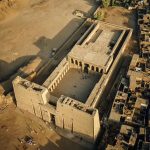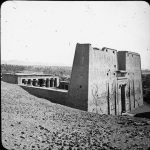IDFŪ (APOLLONŌPOLIS)
| Egyptian | Ḏbȝ | Tbȝ | Dbȝ | Bḥdt | Bḥt | Msn |
| Greek | Ἀπόλλωνος πόλις Μεγάλη |
| Latin | Apollinis | Apollonos Superiore |
| Coptic | etbo | tbo | tbw | cbw |
| Arabic | إدفو |
| English | Apollonopolis (Apollonos Polis - Apollinopolis) Megale (Magna) / Ano (Superior) | Apollonias | Behdet | Bachthis | Polis Phoibou | Mesen | Edfu |
| French | Edfou | Edfoû | Edfu | Idfu |
| DEChriM ID | 67 |
| Trismegistos GeoID | 269 |
| Pleiades ID | 785974 | PAThs ID | 179 |
| Ancient name | Apollonōpolis |
| Modern name | Idfū |
| Latitude | 24.978691 |
| Longitude | 32.872716 |
| Date from | -4500 |
| Date to | 1050 |
| Typology | City |
| Dating criteria | - |
| Description | Three objects in the 4CARE database are considered to have derived from here. One of these was found in-situ in the Necropolis of Naga el-Hisaja al-Gharbi, while the other two are only recorded as having been purchased in Idfū in 1911, with no information available regarding their findspot. As such, their association with the site is dubious. The objects are nonetheless relevant with regards to fourth century Christianity and must be associated with a site given the structure of the database. As such, they are associated with Apollonōpolis despite the apparent absence of Late Roman occupation at the site. Given that this site is included for the sole purpose of providing a geographic anchoring point for these objects, extensive detail, such as a comprehensive bibliography, will not be offered, as most of the available information is not immediately relevant for the period of interest. Instead, some site features will be discussed, and only a narrow bibliography is presented. For more information regarding the early settlement period at the site, which has certainly been of most interest to scholars (Old Kingdom – Ptolemaic Period), see the annual reports published by members of the Tell Edfu Project (TEP). The site of Idfū, ancient Apollonōpolis, is situated on the west bank of the Nile, c. 75km south of Luxor as the crow flies, and was the capital of the 2nd nome of Upper Egypt. Arguably the most remarkable feature of the site, and the feature for which it is best-known, is a Ptolemaic-period temple dedicated to Horus. The settlement is situated some 50m west of this temple, with excavations demonstrating almost continuous occupation of the site from at least the Old Kingdom, with the latest phase of occupation marked by an early Islamic cemetery apparently belonging to the 10th century which came to cover a large part of the tell (Henne 1924: 9; id 1925: 1-2; Bruyère et al. 1937: 98; Gascione 2005: 156). The earliest archaeological work at the site (below) concentrated on the upper-most levels, comprising Islamic-period material, as well as Roman and “Coptic” remains. The way in which these levels were distinguished, however, was not what we would consider today to be methodologically sound. The Roman-period levels (0 – 350CE) were considered to be those devoid of Christian material which was rather situated in the Byzantine levels (considered to extend until c. 750), and these Byzantine levels were themselves considered devoid of Islamic material (Alliot 1933: 2-3; id 1935: 3; Michałowski et al. 1938: 1). Such a means of classification is far too simplistic and there is no doubt that stratigraphic excavation would have revealed a more complex chronology, likely with earlier Christian material which, based on the publications, dates only from the sixth/seventh century onwards, including an apparent monastery (Michałowski et al. 1938: 24; Bruyere et al. 1937: 62). The chronology established by the Polish-French mission argued in favour of an extended temporal pause between the Roman and Byzantine period, with no textual material datable to the third-beginning of the sixth century, in addition to the fact that the two levels were separated by c. 80cm of sebakh, with no additional construction work having taken place. This led the excavators to propose that there was a phase of complete abandonment – or at least partial abandonment – of the city at the end of the second century (Bruyere et al. 1937: 98-99; Michałowski et al. 1938: 2, 22). This theory was further supported by the identification of traces of a destructive fire which was considered too widespread to have been accidental, in addition to a fortified complex which was considered representative of the inhabitants facing frequent threats (Bruyere et al. 1937: 23; Michałowski et al. 1950: 159-160). The ceramic material retrieved during the Polish-French excavation seasons is considered to date predominantly to the sixth and seventh centuries, often being associated with written material (Kalinowska-Habdas 1957), while the textual documents relating to Christianity are of a similar datation (Henne 1924: 4-6; Michałowski et al. 1938: 24; Bruyere et al. 1937: 62, 98; Timm 1984-1992: 1148-1149). In the earlier seasons, however, fourth century material had been identified in the form of numismatic evidence, some of which was associated with Menas flasks (Henne 1924: 21, 26, 34; Alliot 1933: 27). 145 Coptic and Greek ostraca retrieved during the Polish-French missions which were not published in the excavation reports was recently published by Senya Bacot (2009). Also see Delattre and Fournet 2011 for recensions. The nearby cemetery of Ḥagir Edfu, which was explored between 1941 and 1944, was apparently in use from the Late Period to Roman times, and included a church which had made use of a pre-existent tomb. Although the site is described as a cemetery, and still functions today as such (at least it did in the 1940s), several Coptic and Greek ostraca are recorded as having been retrieved from the site (Bey Fakhry 1947: 47-48). While these remain unpublished, and their content is unknown, such objects are rarely found in mortuary contexts and would likely be indicative instead of a settlement area. The area could thus offer a possible alternative origin of the documents we have in the database. |
| Archaeological research | The first recorded archaeological work to have been conducted was that of the Institut français d’archéologie orientale at the beginning of the 20th century, though before this there had been clearance work of the temple between 1860-1861 by Auguste Matiette, and as well as conservation work undertaken by Alexandre Barsanti from 1903-1905. The IFAO missions occurred in 1914, 1922, 1923, 1924, 1928, 1932, and 1933. The first of these was directed by Pierre Lacau and was aimed at recovering Greek papyri. Unfortunately, no report exists for the work conducted during this initial season due to the war, but types of finds are briefly mentioned in a footnote of the report for the season which followed which was directed by H. Henne, who also directed the 1923 and 1924 seasons (Henne 1924: 1, n. 4; id 1925). The next season was directed by Octave Guerard, followed by two directed by Maurice Alliot (Gueraud 1929; Alliot 1933; id 1935). Following on from this period of French exclusivity, a partnership was established with a Polish team led by Kazimierz Michałowski. This French-Polish partnership was maintained for three seasons, after which systematic excavations of the site ceased until the beginning of the 21st century (Bruyère et al. 1937; Michałowski et al. 1938; id 1950). In the mid-20th century, at least two missions were conducted by the local inspectorate of antiquities. The earliest of the two was not conducted on the tell per se, but rather at Ḥāgir Idfū, a cemetery 4km to the west. Work began in 1941 under the direction of Mohammed Effendi Zakaria Ghoneum and was completed in 1944 by Aziz Effendi Morkos Mansour. Only very limited details are available concerning this work but there is, nonetheless, some pages dedicated to it (Bey Fakhry 1947: 47-48). This is more than can be said for the second mission which is known only from a brief reference made in Orientalia, which references a black granite altar found by a certain inspector by the name of M. Ali Hassan in July 1964 (Orientalia 1967: 198). It is very likely that other work by the local inspectorate has gone unrecorded. In addition to this excavation work, Orientalia also records photographic and conservation expeditions (Orientalia 1961: 187; id 1966: 143). Two short surveys were conducted in the 1970s, one by Manfried Bietak in 1975 and the other by Barry J. Kemp in 1976, both of which were focusing on ancient Egyptian urbanism (Bietak 1979; Kemp 1977: 189-192, figs. 3 and 4, pls. XXVa-b and XXVI a-b). Following on from this was the latest work to have been conducted at the site, that of the Tell Edfu Project (TEP), directed by Nadine Moeller and Gregory Marouard. Survey work commenced in 2001, continuing until 2004, during which time the mission was under the auspices of the University of Cambridge. When excavations first commenced in 2005, it was under the umbrella of University College, University of Oxford. Between 2007 and 2020, it was under the auspices of the Oriental Institute, University of Chicago, and until the present, the project is affiliated with Yale University, sponsored by the William K. and Marilyn M. Simpson Endowment for Egyptology. |
• Alliot, M. 1933. Report sur les fouilles de Tell Edfou (1932). Cairo: Institut français d’archéologie orientale.
• Alliot, M. 1935. Report sur les fouilles de Tell Edfou (1933). Cairo: Institut français d’archéologie orientale.
• Bacot, S. Ostraca grecs et coptes de Tell Edfou. Cairo: Institut français d’archéologie orientale.
• Bagnall, R. S., and D. Rathbone. eds. 2017. Egypt from Alexander to the Copts. An Archaeological and Historical Guide, 227-230. Cairo, New York: The American University in Cairo Press.
• Bey Fakhry, A. 1947. “A Report on the Inspectorate of Upper Egypt.” Annales du Service des Antiquités de l’Égypte 46: 47-48.
• Bietak, M. 1979. “Urban Archaeology and the ‘Town Problem’ in Ancient Egypt.” In Egyptology and the Social Sciences. Five Studies, edited by K. Weeks, 110-114. Cairo: The American University in Cairo Press.
• Bruyère, B., J. Manteauffel, K. Michałowski, J. Sainte Fare Garnot, and Ch. Kuentz. 1937. Tell Edfu 1937. Fouilles franco-polonais: rapports I. Cairo: Institut français d’archéologie orientale..
• Delattre, A. and J.-L. Fournet. 2011. “Les ostraca grecs et coptes d’Edfou. À propos d’une publication récente.” Archiv für Papyrusforschung und verwandte Gebiete 57, 1: 79-98.
• Guéraud, M. O. 1929. Report sur les fouilles de Tell Edfou (1928). Cairo: Institut français d’archéologie orientale.
• Henne, H. 1924. Report sur les fouilles de Tell Edfou (1921-1922). Cairo: Institut français d’archéologie orientale.
• Henne, H. 1925. Report sur les fouilles de Tell Edfou (1923-1924). Cairo: Institut français d’archéologie orientale.
• Kemp, B. 1977. “The Early Development of Towns in Egypt.” Antiquity 51: 189-191.
• Michałowski, K., Ch. Desroches, J. de Linage, J. Manteuffel, M. Żejmo-Żejmis. 1950. Tell Edfu 1939. Fouilles franco-polonaises: rapports III. Cairo: Institut français d’archéologie orientale.
• Michałowski, K., J. de Linage, J. Manteuffel, J. Sainte Far Garnot. 1938. Tell Edfu 1938. Fouilles franco-polonaises: rapports II. Cairo: Institut français d’archéologie orientale.
• Timm, S. ed. 1984-1992. Das Christliche-Koptische Ägypten in Arabischer Zeit: Eine Sammlung Christicher Stätten in Ägypten in Arabischer Zeit unter Ausschyss von Alexandria, Kairo, des Apa-Mena-Klosters (Der Abu Mina), der Sketis (Wadi n-Natrun) und der Sinai-Region. Vol. III, 1148-1157 (Idfu). Weisbaden: Dr Ludwig Reichert.


 Json data
Json data





